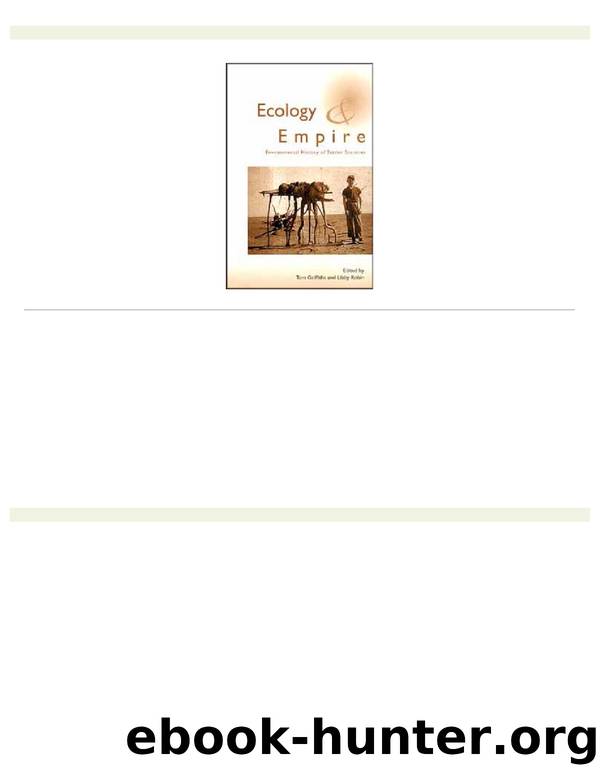Ecology & Empire by Unknown

Author:Unknown
Language: eng
Format: epub
Tags: history, nonfiction
Published: 2012-08-13T12:10:29+00:00
page_138
< previous page
page_138
next page >
Page 138
of Kakadu National Park', in Jim Birckhead, Terry de Lacy and Laurajane Smith (eds), Aboriginal Involvement in Parks and Protected Areas (Canberra: 1992), p. 263.
60. Birckhead et al. (eds), Aboriginal Involvement; Sally M. Weaver, 'The Role of Aboriginals in the Management of Australia's Cobourg (Gurig) and Kakadu National Parks', in Patrick C. West and Steven R. Brechin (eds), Resident Peoples and National Parks: Social Dilemmas and Strategies in International Conservation (Tucson: 1991), pp. 311-33.
61. In South Africa these are called 'contract parks', of which the Richtersveld National Park was the first in 1991: see David Fig, 'Flowers in the Desert: Community Struggles in Namaqualand', in Jacklyn Cock and Eddie Koch (eds), Going Green: People, Politics and the Environment in South Africa (Cape Town: 199), pp. 112-21.
62. Terry de Lacy, 'The Evolution of a Truly Australian National Park', in Birckhead et al. (eds), Aboriginal Involvement, p. 383.
63. David Foster, 'Applying the Yellowstone Model in America's Backyard: Alaska', in Birckhead et al. (eds), Aboriginal Involvement, pp. 363-4.
64. Robbie Robinson (ed.), African Heritage 2000: The Future of Protected Areas in Africa (Pretoria: 1995).
65. World Congress on National Parks, National Parks, Conservation and Development: The Role of Protected Areas in Sustaining Society (Bali: 1982); David Western and R. Michael Wright, Natural Connections: Perspectives in Community-Based Conservation (Washington, DC: 1994); N. Ishwaran, 'Biodiversity, Protected Areas and Sustainable Development', Nature and Resources, 28/1 (1992), pp. 18-25; West and Brechin (eds), Resident Peoples and National Parks.
66. For example, the CITES agreement: see Kevin A. Hill, 'Conflicts over Development and Environmental Values: The International Ivory Trade in Zimbabwe's Historical Context', Environment and History, 1/3 (1995), pp.
335-49.
< previous page
page_138
next page >
page_139
< previous page
page_139
next page >
Page 139
Chapter 9
Scotland In South Africa:
John Croumbie Brown and the Roots of Settler Environmentalism Richard Grove
The emergence of a critique of the environmental impact of settlement in the British colonial empire was pre-eminently a Scottish phenomenon, albeit influenced by some German and French lines of thought. The primacy of a Celtic ecological critique should come as no surprise. Despite King James and the accident of the Act of Union of 1707, Ireland, Wales and Scotland were England's first colonies and empire in a very real sense, subdued only by overwhelming military force, systematic land settlement, and the development of ideologies of occupation, survey and forced population removal. In considering the roots of settler environmentalism, the subjugation of the Scottish landscape and people under 'British' rule is especially significant. This is so not only because it brought wholesale changes in land ownership, major deforestation and population removal, but also because this brutal colonial imposition coincided temporarily with two powerful intellectual movements: the establishment of Scottish Enlightenment universities, where a brilliant flowering of intellectual life and training emerged; and the elaboration of an intellectually rigorous and socially vigorous Calvinist and Congregationalist Protestantism. 1 The mixture was an awkward but potent one. It gave rise, partly in response to the deforestation of Scotland by English soldiers and capital, to much of modern environmentalism
Download
This site does not store any files on its server. We only index and link to content provided by other sites. Please contact the content providers to delete copyright contents if any and email us, we'll remove relevant links or contents immediately.
International Integration of the Brazilian Economy by Elias C. Grivoyannis(74798)
The Radium Girls by Kate Moore(11621)
Turbulence by E. J. Noyes(7700)
Nudge - Improving Decisions about Health, Wealth, and Happiness by Thaler Sunstein(7242)
The Black Swan by Nassim Nicholas Taleb(6764)
Rich Dad Poor Dad by Robert T. Kiyosaki(6175)
Pioneering Portfolio Management by David F. Swensen(6079)
Man-made Catastrophes and Risk Information Concealment by Dmitry Chernov & Didier Sornette(5647)
Zero to One by Peter Thiel(5488)
Secrecy World by Jake Bernstein(4388)
Millionaire: The Philanderer, Gambler, and Duelist Who Invented Modern Finance by Janet Gleeson(4094)
The Age of Surveillance Capitalism by Shoshana Zuboff(3985)
Skin in the Game by Nassim Nicholas Taleb(3965)
The Money Culture by Michael Lewis(3846)
Bullshit Jobs by David Graeber(3830)
Skin in the Game: Hidden Asymmetries in Daily Life by Nassim Nicholas Taleb(3723)
The Dhandho Investor by Mohnish Pabrai(3560)
The Wisdom of Finance by Mihir Desai(3523)
Blockchain Basics by Daniel Drescher(3329)
